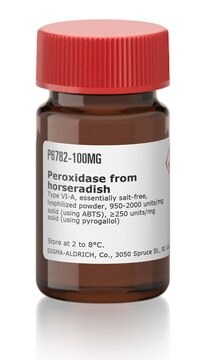C1235
Cholesterol Oxidase microbial
recombinant, lyophilized powder, ≥10 units/mg protein
Synonyme(s) :
Cholesterol: oxygen oxidoreductase
Se connecterpour consulter vos tarifs contractuels et ceux de votre entreprise/organisme
About This Item
Produits recommandés
Niveau de qualité
Forme
lyophilized powder
Activité spécifique
≥10 units/mg protein
Poids mol.
55 kDa
Solubilité
50 mM potassium phosphate buffer, pH 7.0: soluble
Température de stockage
−20°C
Application
Cholesterol oxidase is used to determine serum cholesterol. The enzyme also finds application in the microanalysis of steroids in food samples and in distinguishing 3-ketosteroids from 3b-hydroxysteroids. Transgenic plants expressing cholesterol oxidase are being investigated in the fight against the cotton boll weevil. CHOD has also been used as a molecular probe to elucidate cellular membrane structures.
Actions biochimiques/physiologiques
Cholesterol oxidase (CHOD) is a monomeric flavoprotein containing FAD that catalyzes the first step in cholesterol catabolism. This bifunctional enzyme oxidizes cholesterol to cholest-5-en-3-one in an FAD-requiring step. This is subsequently isomerized to cholest-4-en-3-one with the release of H2O2. Optimum pH of the enzyme is 7.0. Hg2+, Ag+, ionic detergents inhibit the enzyme activity.
Définition de l'unité
One unit will convert 1.0 μmol of cholesterol to 4-cholesten-3-one per minute at 37 °C and pH 7.0 in a peroxidase linked system.
Notes préparatoires
Dissolves in cold 50 mM potassium phosphate buffer, pH 7.0. Solution is to be prepared just before use.
Mention d'avertissement
Danger
Mentions de danger
Conseils de prudence
Classification des risques
Resp. Sens. 1
Code de la classe de stockage
11 - Combustible Solids
Classe de danger pour l'eau (WGK)
WGK 3
Point d'éclair (°F)
Not applicable
Point d'éclair (°C)
Not applicable
Équipement de protection individuelle
Eyeshields, Gloves, type N95 (US)
Faites votre choix parmi les versions les plus récentes :
Déjà en possession de ce produit ?
Retrouvez la documentation relative aux produits que vous avez récemment achetés dans la Bibliothèque de documents.
Bruno M Castro et al.
The Journal of biological chemistry, 284(34), 22978-22987 (2009-06-13)
A uniquely sensitive method for ceramide domain detection allowed us to study in detail cholesterol-ceramide interactions in lipid bilayers with low (physiological) ceramide concentrations, ranging from low or no cholesterol (a situation similar to intracellular membranes, such as endoplasmic reticulum)
Christophe A Marquette et al.
Analytical and bioanalytical chemistry, 390(1), 155-168 (2007-10-03)
The present review draws a general picture of the bioanalytical applications of electro-chemiluminescent reactions (ECL). Only the two main ECL reactions-i.e. the luminol-based and Ru(bpy)(3)(2+)-based reactions-are considered for application in the fields of enzyme biosensors, immunochemical biosensors, DNA biosensors, and
Effect of cholesterol concentration on organization of viral and vesicle membranes. Probed by accessibility to cholesterol oxidase.
R Pal et al.
The Journal of biological chemistry, 255(12), 5802-5806 (1980-06-25)
D R Corbin et al.
Plant physiology, 126(3), 1116-1128 (2001-07-18)
Cholesterol oxidase represents a novel type of insecticidal protein with potent activity against the cotton boll weevil (Anthonomus grandis grandis Boheman). We transformed tobacco (Nicotiana tabacum) plants with the cholesterol oxidase choM gene and expressed cytosolic and chloroplast-targeted versions of
Mitsutoshi Toyama et al.
Protein engineering, 15(6), 477-484 (2002-06-26)
Despite the structural similarities between cholesterol oxidase from Streptomyces and that from Brevibacterium, both enzymes exhibit different characteristics, such as catalytic activity, optimum pH and temperature. In attempts to define the molecular basis of differences in catalytic activity or stability
Protocoles
Enzymatic Assay of Cholesterol Oxidase
Notre équipe de scientifiques dispose d'une expérience dans tous les secteurs de la recherche, notamment en sciences de la vie, science des matériaux, synthèse chimique, chromatographie, analyse et dans de nombreux autres domaines..
Contacter notre Service technique




